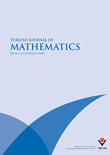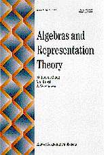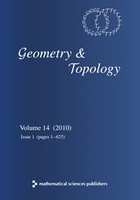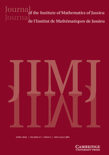
New York Journal of Mathematics
Scope & Guideline
Advancing mathematical frontiers for a global audience.
Introduction
Aims and Scopes
- Algebraic Structures and Operator Algebras:
The journal frequently publishes research on algebraic structures, including operator algebras, which explore the relationships and properties of algebraic systems and their applications in functional analysis. - Topology and Geometric Analysis:
There is a strong emphasis on topology, including studies on manifolds, knots, and surfaces, which address fundamental questions about shape, connectivity, and the properties of spaces. - Representation Theory and Group Theory:
The journal includes works on representation theory, particularly concerning group actions and algebraic representations, which are critical for understanding symmetry in mathematical structures. - Homological Algebra and Cohomology:
Research in homological algebra and cohomology is a significant theme, focusing on the algebraic properties of mathematical objects and their relationships through derived functors and spectral sequences. - Number Theory and Arithmetic Geometry:
The journal publishes papers that delve into number theory, particularly in the context of algebraic structures and their implications, as well as arithmetic geometry, which studies solutions to polynomial equations. - Geometric Topology and Knot Theory:
A consistent focus is observed on geometric topology and knot theory, exploring the properties and classifications of knots and links in three-dimensional spaces.
Trending and Emerging
- Random Structures and Stochastic Processes:
Recent publications have increasingly focused on random structures and stochastic processes, emphasizing their applications in various mathematical contexts and their importance in understanding complex systems. - Higher-Dimensional Algebra and Category Theory:
There is a notable rise in interest in higher-dimensional algebra and category theory, reflecting a shift towards abstract frameworks that facilitate the understanding of mathematical phenomena across different fields. - Noncommutative Geometry:
Emerging themes in noncommutative geometry indicate a growing interest in exploring the geometric aspects of noncommutative spaces, which have implications for both mathematics and theoretical physics. - Mathematics of Data and Machine Learning:
The journal has begun to include more papers that apply mathematical principles to data science and machine learning, showcasing the relevance of mathematics in contemporary technological advancements. - Homotopy Theory and Spectral Sequences:
There is an increased focus on homotopy theory and the use of spectral sequences, reflecting a trend towards deeper investigations into algebraic topology and its applications.
Declining or Waning
- Classical Analysis and Function Theory:
Research related to classical analysis, particularly in the realm of function spaces and traditional analytic methods, seems to be less frequent in recent publications, suggesting a potential waning interest in these areas. - Elementary Number Theory:
Papers addressing basic concepts in elementary number theory have become less prominent, indicating a possible shift towards more complex and abstract mathematical theories. - Discrete Mathematics:
The representation of discrete mathematics topics, such as graph theory and combinatorics, appears to have diminished, signaling a trend towards more continuous and algebraic approaches in recent research.
Similar Journals

Turkish Journal of Mathematics
Exploring the Depths of Mathematical KnowledgeTurkish Journal of Mathematics is a prestigious academic publication dedicated to the advancement of mathematical research across a variety of subfields. Established in 1995 and published by the Tubitak Scientific & Technological Research Council Turkey, this journal has built a solid reputation, especially noted for its significant contributions to the field over the years, with its convergence spanning from 1995 to 2002 and again from 2006 to 2024. The journal, which holds a commendable Q2 ranking in Mathematics (miscellaneous) and is positioned in the 66th percentile of Scopus rankings for General Mathematics, aims to disseminate high-quality original research, reviews, and innovative methodologies to advance both theoretical and applied mathematics. Researchers, professionals, and students alike will find invaluable resources within its pages, providing insights that are pivotal for academic and practical applications in mathematics. Although it does not currently offer open access options, the journal remains an essential platform for those looking to engage with the forefront of mathematical inquiry.

ALGEBRAS AND REPRESENTATION THEORY
Advancing the Frontiers of Algebra and Representation TheoryALGEBRAS AND REPRESENTATION THEORY, published by SPRINGER, is a premier journal that focuses on the cutting-edge developments in the field of algebra and representation theory. With an ISSN of 1386-923X and an E-ISSN of 1572-9079, this journal has fostered a robust platform for both established and emerging researchers since its inception in 1998. As a Q1 journal in the Mathematics miscellaneous category for 2023, it stands out for its rigorous peer-review process and commitment to academic excellence. Although it is not an open-access journal, its broad scope includes significant theoretical advancements and applications that resonate across various mathematical disciplines. Located at VAN GODEWIJCKSTRAAT 30, 3311 GZ DORDRECHT, NETHERLANDS, ALGEBRAS AND REPRESENTATION THEORY continues to contribute meaningfully to the scientific community by providing researchers with essential insights and fostering collaboration in the increasingly complex landscape of mathematics. Researchers, professionals, and students are encouraged to engage with the latest publications, as the journal plays a critical role in shaping contemporary discussions and innovations in the study of algebraic structures.

ANNALES DE L INSTITUT FOURIER
Connecting Scholars Through Cutting-Edge MathematicsANNALES DE L INSTITUT FOURIER is a premier academic journal published by ANNALES INST FOURIER, specializing in the fields of Algebra and Number Theory as well as Geometry and Topology. Since its establishment, the journal has garnered a distinguished reputation, evidenced by its Q1 quartile ranking in the 2023 category assessments and its Scopus Rank of #37 out of 119 in Algebra and Number Theory, and #34 out of 106 in Geometry and Topology, placing it within the top percentile of its field. The journal serves as a vital platform for disseminating groundbreaking research and innovative methodologies, catering to a global audience of researchers, professionals, and students. With a commitment to the advancement of mathematical sciences, ANNALES DE L INSTITUT FOURIER invites contributions that push the boundaries of knowledge and foster collaboration across disciplines. Although it does not offer open access, the rigorous peer-review process ensures that published papers meet the highest academic standards, making it a critical resource for anyone engaged in advanced mathematical research.

Muenster Journal of Mathematics
Championing rigorous peer review for impactful research.Muenster Journal of Mathematics, published by the Westfälische Wilhelms-Universität Münster, Mathematics Institute, serves as a prominent platform for advancing research in pure and applied mathematics. With an ISSN of 1867-5778 and an E-ISSN of 1867-5786, this journal is dedicated to fostering interdisciplinary collaboration among mathematicians, statisticians, and theoretical researchers. While currently not operating under an open access model, the journal ensures that esteemed research contributions undergo rigorous peer review, maintaining high academic standards and integrity. The journal's commitment to disseminating innovative mathematical ideas is reflected in its diverse scope, encompassing fields such as algebra, topology, analysis, and applied mathematics. As a vital resource for researchers, professionals, and students alike, Muenster Journal of Mathematics plays a crucial role in shaping the future of mathematical sciences and fostering scholarly dialogue. The journal welcomes submissions that provide novel insights and methodologies, thereby encouraging the exploration of complex mathematical concepts.

Forum of Mathematics Sigma
Fostering collaboration in the world of mathematics.Forum of Mathematics Sigma is a premier open access journal published by Cambridge University Press that has been at the forefront of mathematical research since its inception in 2013. With a strong emphasis on advancing the fields of mathematics, the journal consistently achieves Q1 rankings across multiple categories, including Algebra and Number Theory, Analysis, and Computational Mathematics. This distinction highlights its impact and relevance within the scholarly community. The journal prides itself on providing a platform for innovative research, fostering collaboration among researchers and practitioners across various mathematical disciplines. Open access publication ensures that cutting-edge findings are widely available to readers globally, enhancing the dissemination of knowledge. With an address in the heart of Cambridge, England, Forum of Mathematics Sigma is dedicated to promoting high-quality research and making significant contributions to the development of mathematics.

Forum of Mathematics Pi
Fostering Collaboration in Cutting-edge ResearchForum of Mathematics Pi, published by Cambridge University Press, stands at the forefront of mathematical research, providing an open-access platform since 2013. With an ISSN of 2050-5086, this journal has rapidly established itself within the mathematical community, particularly noted for its high impact in the realms of Algebra and Number Theory, Analysis, Discrete Mathematics and Combinatorics, Geometry and Topology, Mathematical Physics, and Statistics and Probability, as evidenced by its 2023 Q1 rankings across these categories. Its placement within the top quartile signifies its importance and influence, attracting submissions from leading researchers and academicians around the globe. The journal’s diverse scope and rigorous peer-review process ensure a high standard of scholarly excellence, making it an indispensable resource for professionals, students, and researchers eager to stay informed about cutting-edge mathematical advancements. Access to its comprehensive array of articles is openly available, promoting a culture of collaboration and knowledge sharing in the mathematics community.

Documenta Mathematica
Empowering Global Research Through Open AccessDocumenta Mathematica is a premier academic journal published by the European Mathematical Society (EMS), making significant contributions to the field of mathematics since its inception. With an Open Access model established in 1996, the journal ensures that scholarly works are freely available to a global audience, promoting widespread dissemination of mathematical research. Based in Germany, it serves as a vital platform for mathematicians, covering a wide array of topics within the discipline, evidenced by its impressive Q1 ranking in the miscellaneous category of mathematics as of 2023. Featuring rigorous peer-reviewed articles that span the latest trends and breakthroughs in the discipline, Documenta Mathematica also retains a commendable position among its peers with a Scopus rank of 163 out of 399, placing it in the 59th percentile for general mathematics. Researchers, professionals, and students alike will benefit from the robust scholarly content and the journal's commitment to advancing mathematical knowledge.

GEOMETRY & TOPOLOGY
Pioneering Research at the Intersection of Shapes and SpacesGeometry & Topology is a leading journal in the field of mathematics, focusing on the intricate relationships between geometric structures and topological spaces. Published by Geometry & Topology Publications in the United Kingdom, this prestigious journal boasts an impressive ranking, placing it in the Q1 quartile for Geometry and Topology as of 2023, with a notable Scopus rank of #13 out of 106, indicating its significant impact within the discipline (88th percentile). With publication years spanning from 1997 to 2024, the journal serves as a vital platform for disseminating high-quality research, fostering advances in both theoretical and applied aspects of the field. While it does not currently operate under an Open Access model, it nevertheless attracts the attention of a diverse audience, including researchers, academics, and students eager to explore innovative methodologies and findings in geometry and topology. The journal’s commitment to excellence makes it an essential resource for anyone passionate about mathematical research.

Journal of the Institute of Mathematics of Jussieu
Pioneering Research in the Heart of MathematicsJournal of the Institute of Mathematics of Jussieu, published by Cambridge University Press, is a leading academic journal that has established itself as a vital resource in the field of mathematics. With an impressive impact factor and a ranking in the top quartile (Q1) of miscellaneous mathematics, the journal serves as a platform for high-quality research from both established scholars and emerging researchers. Spanning from 2002 to 2024, the journal aims to foster collaboration and innovation in the mathematical community by publishing original research articles, reviews, and critical discussions on a wide range of mathematical topics. Although the journal does not offer open access, it remains widely accessible through various academic institutions and libraries, ensuring that critical advancements in mathematics are shared with a global audience. Located in the United Kingdom at the prestigious Cambridge campus, the journal reflects the rigorous standards of its publisher and the rich academic tradition of its home institution.

Algebraic Geometry
Exploring the Intersection of Algebra and GeometryAlgebraic Geometry, published by the European Mathematical Society, stands as a pivotal platform in the realm of modern mathematics, focusing on the intricate interplay between algebra and geometry. Since its inception in 2014, this Open Access journal has garnered significant attention, reflected in its prestigious rankings, including Q1 status in the categories of Algebra and Number Theory and Geometry and Topology, as per the 2023 metrics. With an impressive Scopus ranking of #18/119 in Algebra and Number Theory and #18/106 in Geometry and Topology, it ensures high visibility and accessibility of groundbreaking research. Based in Germany, at the esteemed Technical University of Berlin, the journal serves as a beacon for researchers, professionals, and students aiming to push the boundaries of knowledge in these dynamic fields. The scope of the journal encompasses diverse topics, including but not limited to, the latest developments in algebraic structures and geometric configurations, promising to enrich the academic discourse and foster innovation. As we converge towards its tenth anniversary in 2024, Algebraic Geometry continues to evolve and solidify its role as an essential resource for the mathematical community.